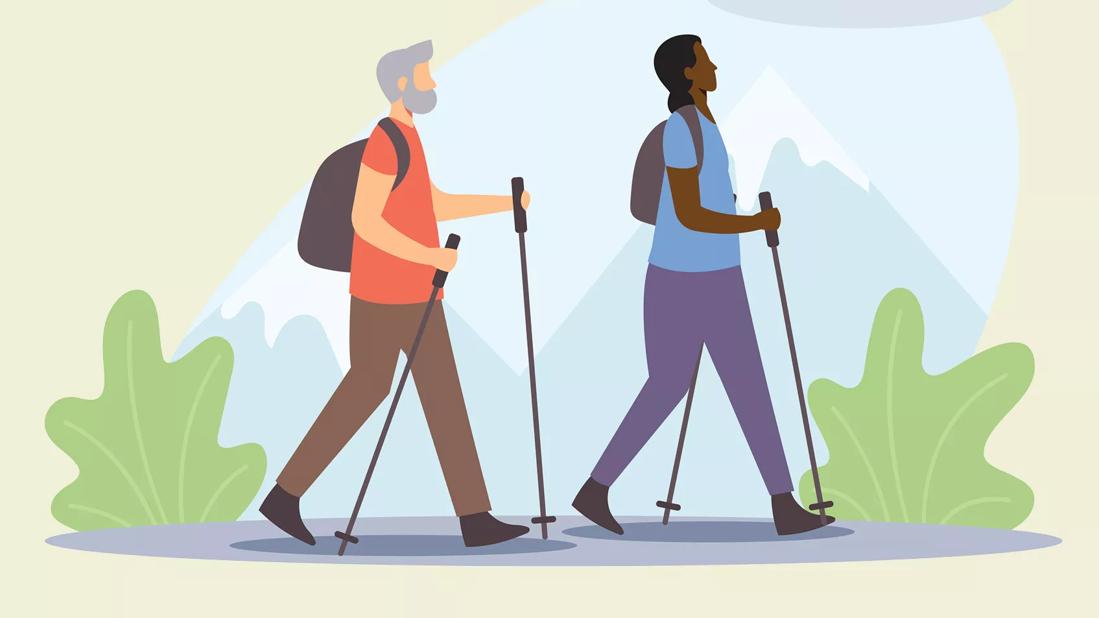Consider a walking program to drop pounds and take a step toward better fitness

So you’re feeling a bit out of shape and want to shed a few pounds? Your weight-loss journey can begin by taking a few thousand extra steps each day.
Advertisement
Cleveland Clinic is a non-profit academic medical center. Advertising on our site helps support our mission. We do not endorse non-Cleveland Clinic products or services. Policy
A dedicated walking program can help improve your overall health and fitness while moving you toward a healthier number on the scale. It’s an easy way to burn additional calories, says exercise physiologist Katie Lawton, MEd.
“A lot of people have a hard time getting motivated to start exercising,” says Lawton. “But walking is simple, right? We do it every day.”
Here’s why you might want to consider doing it more.
Hauling yourself around takes energy — and that’s reflected in the calories spent walking.
A 150-pound person walking a mile in 20 minutes will burn about 80 calories. If you’re heavier, you torch more calories because it takes more energy to move more mass. Likewise, the count is lower if you weigh less.
Other factors influence the calories burned on a walk, too, including:
Advertisement
Any discussion about walking usually starts with a big target: 10,000 steps, which equates to about five miles. But that number doesn’t necessarily translate into truly beneficial cardiovascular exercise.
The reason why is simple: “Not all steps are created equal,” notes Lawton. Slowly shuffling around a store, for instance, boosts your step tally — but it’s not doing a whole lot from a weight loss or fitness point of view.
So Lawton suggests counting minutes instead of steps.
A fitness payoff from walking comes when the activity rises to the level of cardiovascular exercise. That means a minimum of 10 minutes of constant one-foot-in-front-of-the-other movement at a moderate level of intensity.
(NOTE: At moderate intensity, you should be able to carry on a regular conversation while moving, says Lawton. Your rate of perceived exertion, or RPE, should fall between 3 and 5 on a 10-point scale.)
Ideally, you should look to get at least 150 minutes of moderate aerobic activity per week, says Lawton. That follows guidelines set by the American Heart Association. That target, however, is for heart health — not weight loss.
To drop pounds, the activity goal rises a bit. The American College of Sports Medicine, for instance, recommends 200 to 300 minutes of exercise per week for weight loss and long-term weight management.
“The key is to be active,” says Lawton. “The more you’re moving, the more you benefit.” (A wellness expert offers five reasons why you should take a walk today.)
Studies have shown that a regular walking program can help you melt away some extra pounds. Ideally, though, the increase in exercise should be paired with healthier eating habits for weight loss.
“You can’t out-exercise a bad diet,” says Lawton.
Also, enter your walking program with realistic expectations. Putting in daily miles can improve your overall fitness, but it’s not going to give you six-pack ab muscles and a shredded physique, says Lawton.
Dropping pounds is only one perk of wearing out the tread on a pair of walking shoes. Other potential benefits include:
Success in any exercise program starts the same way: By setting aside the time to do it. “You need to make it part of your routine,” says Lawton. “This is about adjusting your lifestyle for your health.”
Start slow in your workouts to build strength and endurance, then gradually increase the intensity as your fitness grows.
Advertisement
The following tips can help to make walking part of your life:
Lawton’s best advice, though? Stay positive and keep at it. “If you miss a day or two, that’s fine,” says Lawton. “Just get back on that horse. Walking to manage your weight or improve your health isn’t a one-day thing. It’s a long-term commitment.”
Advertisement
Learn more about our editorial process.
Advertisement

You can improve your athletic performance over time by breaking up your workout regimen into focused cycles

Lower-intensity workouts can deliver high-quality health and fitness results

Incremental changes in your exercise routine can improve your strength and endurance over time

Understanding heart rate zones can help you tailor your workout to reach your goals

Increase the size of your muscles by bulking up on protein and focusing on slow, intense movements with progressive overloading

Low-impact exercises help you recover faster between sets, during cool downs and on rest days

Eccentric is slow and steady, while concentric is fast and controlled

Weightlifting can help you build muscle mass, reduce joint pain and increase flexibility to improve your quality of life

Babies can get congested easily, but you can calm their cough by keeping them hydrated, using nasal drops and running a humidifier

Weight loss may cause loose, sagging skin and muscle loss to your rear

Several conditions, like vitiligo and fungal infection, can cause a loss of pigmentation, leading to white spots or patches on your skin